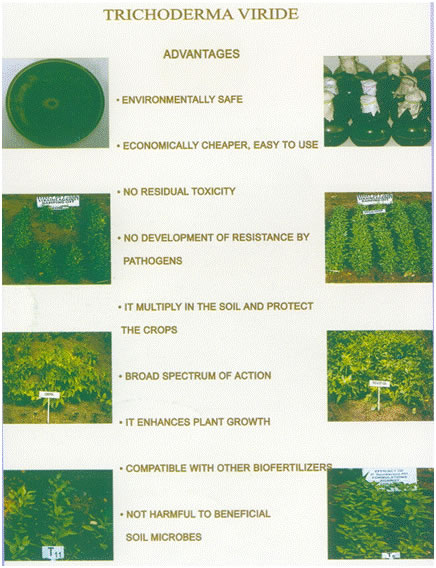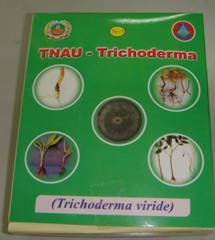Fungal Antagonists
Aspergillus niger
Aspergillus niger, an ubiquitous fungus presents in all types of soil with no specific moisture and pH requirements.
It is formulated as wettable powder. It controls a number of devastating soil borne pathogens e.g. Fusarium oxysporum, Macrophomina phaseolina, Pythium aphanidermatum, Rhizoctonia solani, and Sclerotinia sclerotiorum belonging to different classes of fungi by a single application under different agro climatic conditions in different crops
Myrothecium verrucaria
It is a deuteromycete fungus, which produces cuticle degrading enzymes as well as mycolytic enzymes. It is formulated either in the form of conidia or unicellular yeast like cells. It is used to control root-infecting fungus, Sclerotium rolfsii on groundnut.
Bacterial Antagonists
Entomopathogenic Fungi
Verticillium lecanii
It is known as 'white – halo' fungus because of the white mycelial growth on the edges of infected scale insects. It can be multiplied on medium based on locally available grains and tubers. It is formulated as wettable powder. It is effective against coffee green bug and certain other homopterans.
Beauveria bassiana
It is a deuteromycotina fungus, naturally occurring in soil throughout the world. It is a parasite of different species insect pests, having a wide host range but also insects are attacked at larval or adult stages. It can be mass-produced on locally available grains and other solid substrates. It is formulated as wettable powder, water dispersible granule, and oil based emulsifiable suspension. It is useful against Coffee berry borer, Diamond backmoth, Thrips, Grasshoppers, White flies, Aphid, Codling moth etc.
Metarrhizium anisopliae
Metarrhizium anisopliae is a widely distributed soil-inhabiting fungus. The spore of M. anisopliae can be formulated as dust and sprayable formulation. It isused to control termites, mosquitoes, leaf hopper, beetles etc.
Nomuraea rileyi
Nomuraea rileyi is of cosmopolitan occurrence and pathogenic to a number of economically important lepidopterous pests. It is formulated as wettable powder. The fungus could be multiplied on polished rice grains and crushed sorghum.
Entomopathogenic Bacteria
Bacillus thuringiensis
B. thuringiensis (commonly known as ‘Bt’) is a spore forming gram positive crystalliferous bacterium. It is commercially produced worldwide using fermentation technology. The commercial Bt products are produced as dust, wettable powder and emulsifiable concentrates. The toxin genes have also been genetically engineered into several crop plants.
Entomopathogenic Virus
Baculovirus
The family Baculoviridae includes the Nuclear Polyhedrosis Virus (NPV), Granulosis virus (GV) and Oryctes Granulosis virus. These are double-strand DNA virus (ds-DNA) with rod-shaped nucleocapsids. The virus particles or virions are occluded in protein bodies called polyhedra (NPV) or granules (GV).
Baculoviruses are largely restricted to insects and are host specific. Larvae infected with GV and NPV usually die within 5-12 days after infection. These viruses are produced on the host insects and are formulated both as liquid and dust formulation.
Bacillus subtilis
Bacterial Antagonists
Bacillus subtilis is common non-pathogenic saprophyte that colonises in soil, water and on plant surfaces. It produces a soluble greenish fluorescent pigment. Bacillus subtilis suppress plant diseases by protecting the seeds and roots from fungal infections. This bacterium is mass-produced using fermentation technology.
Method of application
Field crops
1. Paddy-Blast and sheath blight
|
Seed Treatment: Mix paddy seeds with the formulation @ 10g/kg of seed and soak the seeds in water for over night. Decant the excess water and allow the seed to sprout for 24 hours and sow the sprouted seeds. |
Paddy blast Sheath blight |
|
Seedling root dipping: Apply 2.5kg of the formulation to the water stagnated in an area of 25 sq.m. The seedlings after pulling out from the nursery should be placed in stagnated water containing the bacteria. A minimum period of 30 minutes is necessary for soaking the roots and prolonged soaking will enhance the efficiency.
Soil application: Apply the product @ 2.5kg/ha mixed with 50 Kgs of well decomposed farmyard manure (FYM) or sand at 30 days after transplanting. Foliar application: Spray the product @ 0.2% concentration (1Kg/ha) commencing from 45 days after transplanting at 10 days interval for 3 times depending on the disease intensity. If there is no disease incidence, a single spray is sufficient.
II Ragi- Blast
|
Seed treatment: 10g/Kg of seed
Foliar spray: Spray the product @ 0.2% concentration (1kg/ha) after 50% of the flower emergence and again repeat the spray at 10 days after the first spray. |
Ragi blast |
|
III. Groundnut, Gingelly, Sunflower, Redgram, Greengram, Blackgram – Root rot and wilt diseases
Seed treatment: 10 g/Kg of seed
Soil application: Apply 2.5Kg /ha formulation mixed with 50 kg of well decomposed FYM or sand at 30 days after sowing.
IV. Cotton-Root rot and wilt
Seed treatment: 10g/kg of seed
Soil Application: Apply 2.5 Kg/ha formulation mixed 50 Kg of well decomposed FYM/sand at 30 days after sowing.
Horticultural crops
I. Vegetable crops-Damping off
Seed treatment: The seeds of tomato, chillies, bitter gourd, ash gourd, water melon and musk melon have to be treated with formulation at the rate of 10 g per kg of seed 24 hours before sowing to prevent the damping off disease.
Main field application: Apply talc based formulation bacillus subtilis as soil application at the rate of 2.5 kg/ha mixed with well decomposed FYM 50 kgs.
II Cabbage and cauliflower club root disease
Seed treatment: 10g/ha of seed
Soil application: 2.5 kg/ha Bacillus subtilis mixed with 50 kgs of FYM and then applied to the soil before planting.
Seedling root dip: Seedling dip in solution containing formulation of 5g/litre of water for 30 min.
III Mango-anthracnose
Foliar spray with Bacillus subtilis talc formulation at 0.5% concentration with 15 days interval after fruit setting.
IV Banana – Wilt and anthracnose disease
Sucker treatment: 10g/sucker (Paring and pralinage)
 |
Soil Application: 2.5 Kg/ha of formulation+ 50 kg of FYM or Sand. Apply once at the time of planting and repeat it once in 3 months.
Capsule Application: 50 mg/Capsule/Sucker apply once in three months from 3rd month after planting. |
Banana anthracnose Tomato wilt Mango anthracnose |
|
Bunch spray: spray the formulation @ 0.5% concentration at last hand emergence and then at 30 days interval. Combination of all the above treatments will give effective management against the wilt and anthracnose disease with increase in yield.
Uses:
-
Tamil Nadu Agricultural University –1 promotes plant growth and enhances the yield potential of many crops
-
It suppresses the soil borne pathogens like Fusarium, Rhizoctonia, Phytophthora and Pythium species and many nematodes.
-
It induces systemic resistance in plant system against plant pathogens.
Note:
-
Talc based formulated product should not be mixed with fungicides.
-
It should be used with in four months from the date of manufacture
-
It is compatible with biofertilizers
-
It is not harmful to the earthworm and other beneficial organisms living in the soil.
 |
|
Tea blight Sugarcane red rot Banana wilt |
| |
 |
Yield maximization in paddy, cabbage, banana |
Fungal Antagonists
Trichoderma spp.
Trichoderma viride, T. harzianum and T. virens are most extensively used fungal antagonists. They are mass-produced using fermentation technology. They are used for the management of soil borne pathogens by seed treatment and soil application.


Contact
The Professor and Head
Department of Plant Pathology
Centre for Plant Protection Studies
Tamil Nadu Agricultural University,
Coimbatore-641 003.
Phone – 0422 – 6611446
0422 - 6611226
E-mail:pathology@tnau.ac.in |
 |
|

